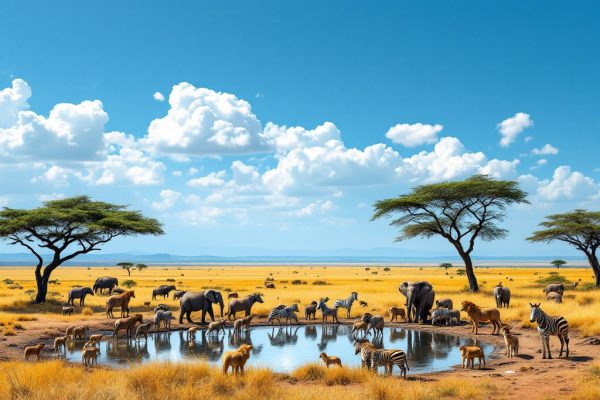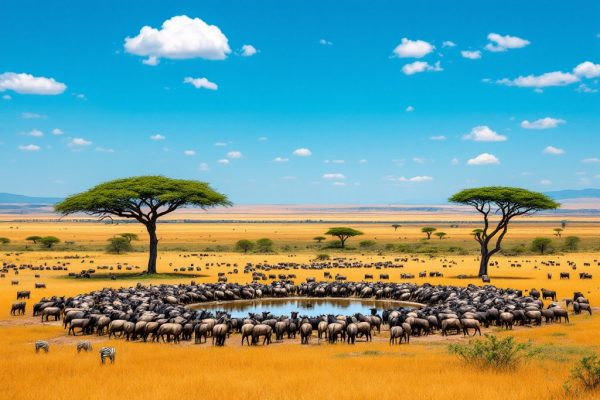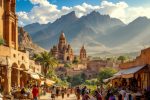How to Organize a Trip to Ethiopia
Dreaming of Ethiopia’s ancient wonders and breathtaking landscapes? Plan your unforgettable adventure with our comprehensive guide! Learn about visa requirements, essential packing tips, and safety advice for a worry-free trip. Discover the best time to visit, diverse transportation options, and unique accommodations, from luxury hotels to eco-lodges. Explore suggested itineraries, including the Historic North Circuit and stunning mountain treks. Uncover the vibrant culture, savor delicious cuisine, and prepare for an enriching Ethiopian experience. Start planning your journey today!
Important information

- A visa is required to enter Ethiopia. Many nationalities can get an e-Visa online. Some are eligible for a visa on arrival, while others must apply through an embassy.
- Passports must be valid for at least six months after your planned departure from Ethiopia. Travel insurance is strongly recommended.
- The best time to visit is during the dry season (October to May) for optimal weather. The rainy season (June to September) can hinder travel.
- Ethiopia offers diverse transport. Domestic flights, buses, and car rentals are available. Addis Ababa Bole International Airport (ADD) is the main entry point.
- Be aware of dual pricing, where foreigners might pay more. Negotiate, especially in markets. Learn basic Amharic phrases for better interactions.
Understanding Ethiopian Travel Requirements
Planning a trip to Ethiopia? A visa is essential for your journey. Many nationalities can easily obtain an e-Visa online, providing a quick and convenient option. You can find more information about the required eVisa Ethiopia at eVisa Ethiopia. Some travelers may be eligible for a visa on arrival. Others should contact the nearest Ethiopian embassy or consulate for specific requirements. Ensure your passport is valid for at least six months beyond your intended travel dates. Travel insurance is highly recommended for a worry-free trip. Prepare for an unforgettable Ethiopian adventure!
How to Get a Visa for Ethiopia
Applying for an e-Visa online is a convenient option, but be sure to review the specific visa requirements for your nationality. Your passport’s validity must extend six months beyond your travel dates. Some nationalities can obtain a visa upon arrival, while others must secure one from an embassy in advance. Confirm the process well before your departure.
Travel Insurance for Ethiopia
Planning a trip to Ethiopia? Consider travel insurance for peace of mind and financial protection against unexpected events. Travel insurance can cover medical emergencies, trip cancellations, and lost luggage. Carefully review policy details, as coverage limits and exclusions may apply. Choose a plan that best suits your needs.
Essential Items to Pack for Your Trip
Pack smart for your trip with these essentials:
- Versatile clothing layers, to adapt to changing weather conditions.
- Essential travel documents: passport, visa, and booking confirmations.
- Small first-aid kit, with necessary medications, insect repellent, and sunscreen.
- Safety and convenience items: money belt, portable charger, and universal adapter.
- Toiletries and a reusable water bottle, to stay refreshed.
- Basic language guide, to enhance interactions with locals.
- Camera and journal, to preserve memories.
- Personal items, for maximum comfort and enjoyment.
Is It Safe to Travel to Ethiopia?
Ethiopia offers a generally safe experience for tourists, but staying well-informed is essential. Consult your government’s travel advisories for valuable safety information, including region-specific guidance and updates on evolving security situations. Remember to check for travel restrictions and safety warnings both before and during your trip.
Travel Safety Tips and Advice
Planning your Trip
- research local customs and laws,
- leave expensive jewelry and electronics at home,
- register with your embassy and share your itinerary with someone you trust,
- learn basic Amharic phrases,
- keep copies of your passport and visa with you,
- ensure your tour operators are reputable.
Safety Precautions
- stay aware of your surroundings, especially in crowded areas,
- avoid walking alone at night, especially in unfamiliar areas; stick to reliable transportation,
- exercise caution with food and drinks from strangers,
- report any suspicious activity to the authorities.
Health and Medical Advice
- consult your doctor about recommended vaccinations and necessary precautions,
- pack a well-stocked first-aid kit and all essential medications,
- consider travel insurance that covers medical emergencies and evacuations,
- be prepared for potential altitude sickness in mountainous regions.
Food and Hygiene Tips
- stick to bottled or purified water,
- avoid raw or undercooked food,
- practice good hygiene,
- familiarize yourself with local health resources and emergency contacts.
Understanding the Impact of the Tigray War
The Tigray conflict has made travel within the region unsafe, so tourists should avoid the area. Neighboring regions, including Amhara and Afar, are also experiencing disruptions that impact travel routes and safety. Always heed your government’s travel advisories and avoid these areas if recommended.
Many other Ethiopian tourist destinations remain largely unaffected. The historic north circuit, encompassing Gondar, Axum, and Lalibela, is still accessible. Similarly, the Simien and Bale Mountains, along with the Omo Valley, are open to visitors. However, it’s always wise to check current safety conditions before traveling anywhere in Ethiopia. Consider travel insurance that covers political instability as a smart precaution.
Best Time to Visit Ethiopia
Dry Season (October – May)
Ethiopia’s dry season, spanning from October to May, offers comfortable temperatures and minimal rainfall. This period is perfect for exploring the country’s diverse landscapes and historical sites. Discover the rock-hewn churches of Lalibela or embark on challenging treks in the Simien Mountains. The abundant sunshine and pleasant weather make travel easy and enjoyable throughout the country.
Rainy Season (June – September)
From June to September, Ethiopia experiences its rainy season. Heavy downpours can make travel challenging, transforming roads into muddy tracks. However, this season offers a unique perspective of Ethiopia’s landscapes. Witness the vibrant greenery that erupts across the country, transforming familiar sights like the Simien Mountains into a showcase of nature’s renewal.
Understanding the Dry Season
Discover Ethiopia during its dry season, from October to May, when sunshine and low humidity create perfect conditions for trekking. The Simien and Bale Mountains offer breathtaking trails, but other regions also hold unique treasures. Explore the otherworldly landscapes of the Danakil Depression or immerse yourself in the vibrant cultures of the Omo Valley. Wildlife viewing is exceptional during these months, as animals congregate around water sources, offering incredible photo opportunities. Plan your Ethiopian adventure for the dry season and experience unforgettable landscapes, vibrant cultures, and captivating wildlife encounters.
What to Expect During the Rainy Season
Ethiopia’s rainy season, spanning June through September, brings heavy downpours and the potential for flooding and travel disruptions. While this period is considered the tourism off-season, the rains create lush, vibrant landscapes. An advantage is potentially lower prices. As an alternative, consider visiting during the shoulder seasons of May and October, which offer pleasant weather and fewer crowds.
Transportation Tips: How to Travel Around Ethiopia
Traveling within Ethiopia offers a variety of transportation options to suit different needs and budgets. For efficient long-distance travel, domestic flights connect major hubs like Addis Ababa to destinations such as Lalibela and Gondar. Buses provide a budget-friendly alternative, reaching most towns, though travel times can be longer. Renting a private car offers maximum flexibility, allowing you to explore areas not accessible by bus. Most international visitors arrive at Addis Ababa Bole International Airport (ADD).
Arriving at Ethiopia’s International Airports
Ethiopia’s primary entry point for international travelers is Addis Ababa Bole International Airport (ADD). International flights also land at the following airports:
- Dire Dawa (DIR),
- Mekelle Alula Aba Nega (MQX),
- Bahir Dar Ginbot Haya (BJR).
All arriving passengers must clear immigration and customs.
Using Public and Private Ground Transport
Ethiopia offers diverse public transportation options. For long-distance travel between cities and regions, you can choose from full-size buses or minibuses. Within city limits, taxis and tuk-tuks are readily available. If you prefer private transport, hiring a car and driver provides greater flexibility.
Accommodation: Where to Stay in Ethiopia
Ethiopia offers a range of accommodations for every traveler. Whether you prefer luxury hotels in vibrant cities like Addis Ababa or budget-friendly guesthouses and homestays in smaller towns and rural areas, you’ll find a suitable option. For a unique and immersive experience, consider camping or staying in an eco-lodge, especially in national parks like the Simien Mountains. Booking accommodations online is recommended, particularly during peak season.
Luxury Accommodation Options
Ethiopia offers a wealth of luxurious accommodations. Upscale hotels and lodges are available in Addis Ababa and other urban centers, providing premium amenities and exceptional service. Beyond the cities, high-end options are also situated near popular tourist destinations, ensuring comfort and style as you explore Ethiopia’s remarkable attractions.
Mid-Range Hotels and Basic Lodging
Ethiopia offers a range of accommodation options, from mid-range hotels concentrated in cities to basic lodgings prevalent in the south.
Camping and Eco-Lodges in Ethiopia
Experience Ethiopia’s stunning landscapes through unique accommodations and camping adventures. Eco-lodges, often located near breathtaking sites like the Simien Mountains, Bale Mountains National Park, and the Omo Valley, offer sustainable stays that minimize environmental impact and engage local communities. For a closer connection with nature, explore diverse camping options, ranging from organized campsites with amenities to remote, wild experiences.
Must-Visit Places and Itineraries in Ethiopia
Explore northern Ethiopia’s ancient wonders, including Axum’s towering obelisks and Gondar’s royal castles. Discover Lalibela’s rock-hewn churches, a UNESCO World Heritage site.
Discover Ethiopia’s Natural Wonders
Trek through the breathtaking Simien Mountains National Park, home to the Walia ibex and Gelada baboon. Explore the Bale Mountains National Park, a sanctuary for the rare Ethiopian wolf.
Explore Cultural and Geological Marvels
Experience the vibrant tribal cultures of the Omo Valley. Witness the surreal landscapes of the Danakil Depression, one of Earth’s hottest and lowest points, with its salt flats, volcanoes, and mineral deposits.
Days 1-2: Addis Ababa
Explore Ethiopia’s bustling capital city.
Days 3-4: Lalibela
Discover the magnificent rock-hewn churches.
Days 5-6: Simien Mountains
Trek through stunning mountain landscapes.
Days 7-8: Gondar or Omo Valley
Explore the royal castles of Gondar or the rich cultural heritage of the Omo Valley.
Exploring the Historic North Circuit
Embark on a captivating journey through Ethiopia’s Historic North Circuit, exploring ancient wonders and rich cultural heritage.
Begin in Gondar, home to impressive castles and the Debre Birhan Selassie church, where the angel-adorned ceiling will leave you breathless.
Continue to Bahir Dar, nestled on the shores of Lake Tana, and explore its serene island monasteries, guardians of ancient religious manuscripts.
The journey’s highlight is Lalibela, a UNESCO World Heritage site, renowned for its remarkable rock-hewn churches.
Finally, uncover the mysteries of the ancient Aksumite kingdom in Aksum, with its towering obelisks and fascinating archaeological ruins.
Each destination on this unforgettable circuit offers a unique window into Ethiopia’s vibrant past.
Discovering the Simien and Bale Mountains
Ethiopia’s Simien Mountains, a UNESCO World Heritage site, boast dramatic cliffs and breathtaking vistas. Here, you can encounter unique wildlife, including the Walia ibex. Further south, the Bale Mountains National Park presents a diverse range of landscapes, from Afro-alpine moorlands to juniper forests, providing a haven for Ethiopian wolves and numerous bird species. Both mountain ranges offer challenging but rewarding treks, promising an unforgettable experience.
Simien Mountains National Park
Dramatic cliffs and breathtaking vistas, home to the unique Walia ibex.
Bale Mountains National Park
Diverse landscapes from Afro-alpine moorlands to juniper forests, sheltering Ethiopian wolves and numerous bird species.
Both mountain ranges offer challenging but rewarding treks for an unforgettable experience.
Visiting the Omo Valley and Danakil Depression
Ethiopia’s Omo Valley is a vibrant tapestry of unique cultures, home to tribes like the Mursi, Hamer, and Karo. Beyond the Omo Valley, the Danakil Depression stands as one of the planet’s hottest and lowest points, a harsh landscape shaped by the Dallol sulfur springs and the fiery Erta Ale volcano.
Suggested 8-Day Itinerary for First-Time Visitors
Day 1: Arrive in Addis Ababa, check into your hotel, and explore the National Museum and Merkato, Africa’s largest open-air market.
Day 2: Travel to Bahir Dar to visit the Blue Nile Falls and the monasteries on Lake Tana.
Day 3: Explore Gondar’s Royal Enclosure, including Fasilides’ Bath and Debre Berhan Selassie Church.
Day 4: Discover the rock-hewn churches of Lalibela, a UNESCO World Heritage Site.
Day 5: Fly to Axum and visit ancient obelisks, the Queen of Sheba’s Palace ruins, and the Church of Our Lady Mary of Zion.
Day 6: Return to Addis Ababa and visit the Holy Trinity Cathedral and the Ethnographic Museum.
Day 7: Choose between a day trip to the UNESCO site of Tiya, known for its ancient stelae, or further exploration of Addis Ababa.
Day 8: Depart from Addis Ababa Bole International Airport (ADD).
Top Experiences in Your Trip to Ethiopia
From the soaring peaks of the Simien Mountains to the depths of the Danakil Depression, Ethiopia’s landscapes offer breathtaking variety. Visitors can explore this diverse terrain through hiking, wildlife viewing, and discovering unique geological formations. Ethiopia’s national parks, such as Bale Mountains and Simien Mountains National Parks, are havens for endemic species like the Ethiopian wolf and Walia ibex.
The Simien and Bale Mountains provide challenging yet rewarding trekking experiences. Experienced hikers can embark on multi-day adventures, while shorter trails cater to those seeking less strenuous options. Guided treks offer valuable local insights and knowledge.
Ethiopia’s rich history comes alive in its ancient cities and remarkable rock-hewn churches. Lalibela, a UNESCO World Heritage site, is renowned for its eleven monolithic churches carved directly from rock. Gondar, the former capital, boasts impressive castles and royal enclosures. Engaging with local communities offers a deeper understanding of Ethiopia’s vibrant cultures and traditions.
Exploring Natural Beauty and Outdoor Activities
Ethiopia is a haven for outdoor enthusiasts, offering a diverse range of adventures. Explore the unique wildlife and breathtaking views of the Simien Mountains National Park, home to the Walia ibex and Gelada baboon. Discover the Bale Mountains National Park, where you might spot the rare Ethiopian wolf and marvel at the diverse birdlife. For a truly unforgettable experience, visit the Danakil Depression. It is one of the hottest and lowest places on Earth, boasting otherworldly landscapes and active volcanoes. Lastly, embark on serene boat trips on Lake Tana, the source of the Blue Nile, and discover ancient island monasteries.
Exceptional Trekking Routes
Ethiopia is a trekking paradise with adventures for everyone. The Simien Mountains National Park offers challenging treks with stunning vistas and rare wildlife, including the Walia ibex and Gelada baboon. For a different experience, explore the Bale Mountains National Park, home to Ethiopia’s second-highest peak and trails through forests, alpine meadows, and volcanic terrain. Thrill-seekers can tackle the Danakil Depression, one of the planet’s hottest and lowest points, trekking across salt flats and near active volcanoes. The Tigray region, famed for its rock-hewn churches, also presents demanding but rewarding treks across dramatic landscapes.
Visiting Historic Sites and Cultural Communities
Ethiopia, a land steeped in history and culture, offers a wealth of captivating destinations. Explore Lalibela’s rock-hewn churches, a UNESCO World Heritage site, and marvel at these architectural wonders carved entirely from solid rock. Journey to Gondar, a former royal city, and discover its magnificent castles, palaces, and churches dating back to the 17th and 18th centuries. Venture into the Omo Valley and encounter diverse indigenous communities with fascinating traditions, gaining valuable insights into their unique way of life. Delve into Ethiopia’s rich past at the National Museum in Addis Ababa, where you can view artifacts spanning the country’s history, including the renowned Lucy fossil.
Cultural Highlights and Ethiopian Festivals
Ethiopia, a land of remarkable cultural diversity, is home to over 80 distinct ethnic groups. Each contributes unique traditions, languages, and customs. Among the major groups are the Oromo, Amhara, Tigray, and Sidama. They maintain their identities while weaving together a vibrant national tapestry. Pre-trip research on these groups enhances cultural understanding and appreciation.
Ethiopian Festivals
Ethiopian festivals offer a spectacular showcase of the country’s vibrant culture. Genna, Ethiopian Christmas, falls on January 7th and features unique religious services. Timkat, commemorating Jesus Christ’s baptism, includes colorful processions and symbolic reenactments. These festivals provide valuable insights into religious practices and community traditions.
Participating in Festivals
If your travels coincide with these events, participating offers an immersive cultural experience.
Understanding the Cultural Diversity and Ethnic Groups
Ethiopia is a multicultural land with over 80 distinct ethnic groups, each contributing to its rich heritage through unique traditions, languages, and customs. Among the largest are the Oromo and Amhara, followed by the Tigray and Somali. Visitors to this diverse nation can experience a wide array of cultural expressions, from music and dance to unique clothing and cuisine. Religious practices are equally varied, with Ethiopian Orthodox Tewahedo Christianity being prominent alongside Islam and traditional beliefs. Engaging with these communities offers a vibrant journey through Ethiopia’s cultural landscape.
Participating in Ethiopian Festivals like Genna and Timkat
Experience the vibrant culture of Ethiopia by immersing yourself in its unique festivals:
Genna
Celebrated on January 7th, Genna marks Ethiopian Christmas. Attend church services and witness traditional games for a truly immersive experience. This festival offers unique insights into Ethiopian religious practices and the significance of communal celebrations.
Timkat
Timkat commemorates Jesus’s baptism (Epiphany) on January 19th, or the 20th in a leap year. Colorful processions and reenactments of the baptism are key features of this festival. Experience the unique insights into Ethiopian religious practices and communal celebrations.
Ethiopian Cuisine: Food and Drinks
Experience the unique culinary adventure of Ethiopian cuisine, centered around injera, a spongy sourdough flatbread. This staple acts as both plate and utensil, used to scoop up flavorful stews called wot. These wots typically combine vegetables and meats in a rich blend, creating complex and satisfying dishes. Ethiopian dining is a communal experience, where diners share from a common platter, using their right hand to tear injera and savor the wot. This shared meal strengthens social bonds. Inform your host or restaurant staff about any dietary restrictions. Ethiopia also has a vibrant coffee culture, with traditional ceremonies offering insight into the country’s hospitality and rich traditions. Participating in a coffee ceremony and sampling the local cuisine enhances any visitor’s cultural experience.
Popular Dishes: Injera, Wot, and Tibs
Injera, a spongy sourdough flatbread, is essential to Ethiopian cuisine. It serves as the base for a variety of rich stews, called wot. These stews can include beef, lamb, chicken, lentil, and vegetable versions. Another popular dish is tibs, which features sautéed or grilled meats. These meats can be beef, lamb, goat, or chicken, seasoned with onions, peppers, and spices. Uniquely, injera also serves as the utensil, used to scoop up the flavorful wot and tibs.
Experiencing Ethiopian Coffee Culture
Ethiopian coffee culture centers around a traditional ceremony, deeply embedded in their hospitality and social life. The ceremony involves several key steps:
Green coffee beans are roasted.
The roasted beans are then ground.
The ground coffee is brewed in a jebena, a traditional clay pot.
The coffee is served in small, handleless cups.
This ritual offers a unique taste of Ethiopian culture.
More Resources for Traveling in Ethiopia
Explore Ethiopia with invaluable travel guides, unlocking secrets of diverse regions, cultures, and attractions. Local tours offer enriching experiences, often including transportation, accommodation, and expert guidance, streamlining your journey and providing in-depth knowledge. Navigate unfamiliar territories with ease, gain insights into local customs, and unlock unique experiences. Reputable tour operators specializing in Ethiopian travel ensure a seamless and enriching adventure, mitigating potential challenges like language barriers and transportation logistics. They also provide access to remote areas and may offer specialized activities, such as trekking or cultural immersion programs.
Bargaining and Pricing in Ethiopia
Be aware of dual pricing in some tourist areas where foreigners may encounter higher prices. Negotiating is key, especially in markets or when hiring taxis. Research typical costs beforehand to avoid overpaying and protect against scams like inflated prices for souvenirs or services. Patronize reputable businesses and tour operators.
Learning basic Amharic phrases can be advantageous for bargaining and interacting with locals, often leading to fairer prices. If uncertain about a price, compare quotes from multiple vendors or seek advice from your hotel or guide. Exercise caution with unsolicited offers, particularly those that appear too good to be true.
Tips for Smart Bargaining
- Research typical costs for goods and services.
- Negotiate respectfully but firmly.
- Compare prices from multiple vendors.
- Learn basic Amharic phrases.
- Seek advice from trusted sources like your hotel or guide.
- Be wary of unsolicited offers.
Travel Guides and Local Tours
Travel guides offer a wealth of information on attractions, transportation, and accommodations, plus valuable cultural insights. For a more immersive experience, consider a local tour led by knowledgeable guides who can provide unique perspectives and lead you to hidden gems.
Dealing with Scams and Dual Pricing
Dual pricing is common in Ethiopia, with foreigners often paying more. Always negotiate prices in advance, especially for market purchases and souvenirs. Be cautious of unofficial guides and tour operators offering unusually low prices, as these can be misleading. Researching typical costs for goods and services will help you avoid overpaying. If you are unsure about a fair price, ask your hotel or a trusted local for advice.

















